Jirka Pacák is an experienced captain and rarely caught off guard — not even when a mast collapsed on his sailing boat on the way to the Aeolian Islands during a sports sailing course. How did he resolve this crisis so far from the mainland and what was his advice to the crew? Unfortunately, this type of incident can occasionally occur when at sea, so we're going to take you through how to spot a potential problem even before setting sail and what to do if the worst happens.
Setting sail on a wild voyage to the Aeolian Islands
We set off on a Friday evening, after dark. I didn’t want to wait for morning. A marked worsening of the weather from the south was forecast from Sunday to Monday and so I wanted to reach the sheltered marina on Lipari as soon as possible.
If we had waited, the worst of the weather would have hit us en route. We had at least 21 hours of sailing ahead of us, much longer if beating to windward. Precisely because it is an advanced sailing trip, more challenging situations are planned for the crew to try out.
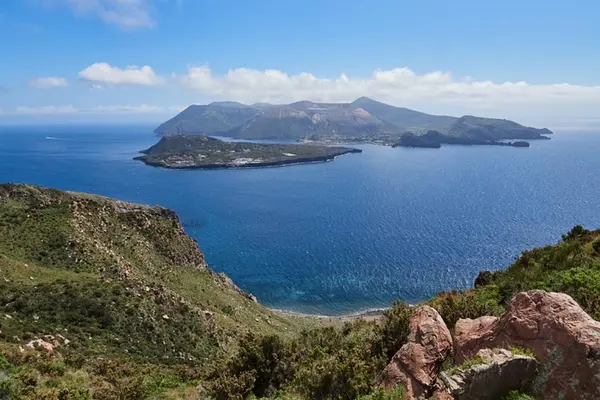 Yachting in the Aeolian Islands, one of the most beautiful locations
Yachting in the Aeolian Islands, one of the most beautiful locations YACHTING.COM TIP: Take up the challenge of the god of winds, Aiola, and experience the adrenaline rush of the Aeolian Islands. The Aeolian Islands (sometimes referred to as the Lipari Islands) lie off Sicily at the very south of the Tyrrhenian Sea and are named in honour of the Roman god of winds, Aiola. The archipelago consists of seven larger volcanic islands and a number of smaller rocks.
All of a sudden, during the night, there was a thud on deck
I divided up the tasks and as there was no decent wind, we motored upwind. The sails were down. The crossing was a bit wild due to the waves, some of the crew vomited, but otherwise, everything went smoothly. On Saturday around 2 o'clock we had only the last 45 NM to go.
Suddenly there was a loud thud on deck. I immediately ran out on deck. A shroud had worked its way loose and was thrashing wildly in the wind, hanging like a washing line. I immediately looked to see what had happened, thinking the shroud had become unhooked when the mast was battered by waves.
 Collapsed mast on deck
Collapsed mast on deck But looking up, everything looked perfectly normal, nothing else had come loose or fallen. Then there was another faint thud and the mast began to collapse. It landed on the sprayhood, fell in the aft bin and plunged into the water.
At that moment there were 3 people including myself on deck — one at the helm, right where it fell. Luckily, nobody was hurt. If we had been in a storm under sail, it would have been much worse.
What we did right after the mast fell
I immediately shifted into neutral. The boat then turned broadside to the waves and began to rock. Naturally, the mast started to move about sharply and threatened to sweep someone into the sea, buckle or damage the boat.
It was essential to swiftly still the mast. It was jammed into the boom vang and rigging lay all around it. The boom was lying across the cockpit, it had fallen on the cockpit lockers and there were things in the way everywhere. The jib and roller furler were torn and half in the water.
 A snapped forestay caused the mast to fall
A snapped forestay caused the mast to fall Why did the mast fall? The strong steel forestay which runs through the roller furler and connects the roller furler and mast had snapped. The mast was not broken, but had come free at the heel and completely shifted position. Maybe the material was defective, maybe the forestay was ‘past it’. So why didn’t it fall straight away? It was probably being held up by the genoa halyard.
How one of the crew perceived the mast fall
"After night and morning watch I was asleep in my sleeping bag, enjoying a moment of peace and finally feeling fine after a bit of a bumpy night. The engine just purred. The waves grew a bit smaller and longer.
I was awakened by a strange cracking sound above me. Then a dull thud right above my starboard aft cabin. The engine cut out. A moment of quiet. Straight away I knew we’d been dismasted.
After a moment of shock, I started to get dressed. People were talking normally on deck. The boat wasn’t taking on water. I forced my way on deck past the destroyed sprayhood.
The skipper was already on deck with the sailors who were there when the mast collapsed. The skipper's first question: Is everyone OK? Yes. Anyone overboard? No. The skipper handled it magnificently."
To cut or not to cut a fallen mast
One option was to immediately cut down the mast and get rid of it. As nightfall and worsening weather were approaching, there wasn’t much time for deliberation. I discounted this idea for various reasons and am glad I did.
So we decided to try and pull the mast onto the boat and secure it. I used the anchor windlass to manoeuvre it. We attached the mast heel to it using ropes and various odds and ends. I threw out the chain and hauled the mast on deck.
 Collapsed mast tied to the side of the boat
Collapsed mast tied to the side of the boat We managed to move it slightly, but no more. One of the spreaders was caught in the railing. Now what? The mast was still vibrating and there was a risk of it falling into the water. We secured it to a cleat and looked for tools to free the spreader. In the meantime, the guys removed the boom vang (luckily it wasn’t hydraulic or there would have been oil everywhere). Even so, they were all filthy.
We also unscrewed the boom and stowed it port side. We couldn’t free the spreader, however. I wanted to bend the railing and unhook the spreader. Time was running out. If the weather had deteriorated it would have been a real problem, hence the need for speed. Things could always get worse.
We then tied the mast to the side and with the aid of the winch we pulled it up a bit further. Eventually, we managed to get most of it on board and the bit hanging over (around 7 m) stayed above the water surface and was only partly submerged in the waves. The boat was obviously easier to steer now. The roller furler and the rest of the mast were almost on deck.
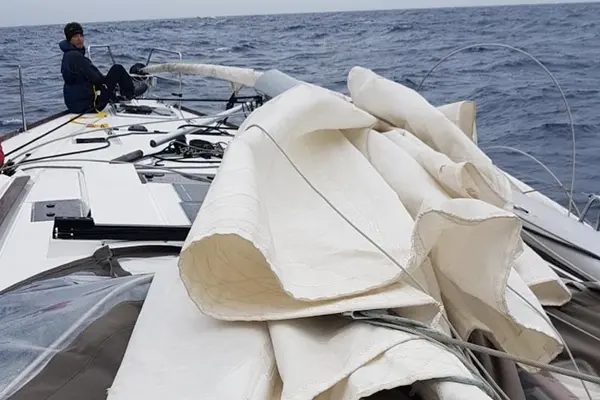 Lines and shrouds lying around the mast
Lines and shrouds lying around the mast We also cut down the running rigging (topping lift, spinnaker halyard, mainsail and jib halyard and we even cut the sheets at the heel and pulled them through). We pulled all the steel lines tight so there was no way they could get near the propeller.
We stowed the cut-off bits in the cockpit lockers. There’s always the possibility that something else could happen (MOB, for example) and you might get caught up in all the things left in the way. Even when there’s not much time in the moment, it’s good to keep that in mind. It took us about an hour to an hour and a half to sort it out.
Useful yachting tips:
No radio or signal to contact port...
Due to the VHF antenna being located on the collapsed mast, we could no longer use the radio. Every sailor should be aware of this and plan for it. If there had been an injured crew member, we would have had a problem calling for help. There wasn’t even a GSM signal.
As the weather was improving, it was possible to carry on, so we continued the approximately 45 NM trip to Lipari. Panarea and Stromboli were closer, but we would not have been sheltered from the waves there. There was on-board GPS, so that was not a problem. It showed our arrival time as around 9 pm.
When we got a GSM signal, we contacted the marina in northeastern Lipari, so they could make room for us. They came to meet us and even moved some boats to make room for us. We moored bow-to the pontoon and tied a flashing light to the mast so nobody would bump into it.
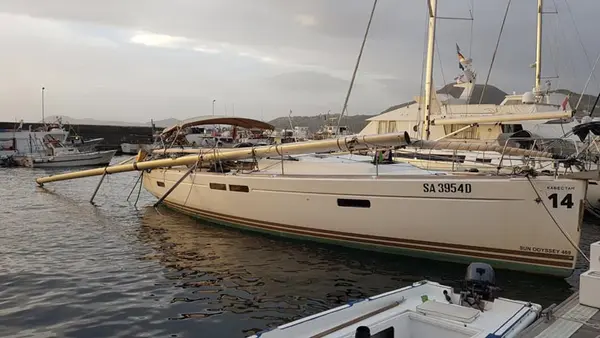 Boat with broken mast moored in the marina
Boat with broken mast moored in the marina How did the charter and insurance companies handle the accident?
We sent a text message to the charter company that night and by morning there was a busy exchange between yachting.com and Italy. A replacement boat was supposed to arrive on Tuesday afternoon. The captain left Tropea, but after 20 NM — around halfway — he had to turn back. The Italian captain assessed the situation and considered continuing the voyage to be too risky.
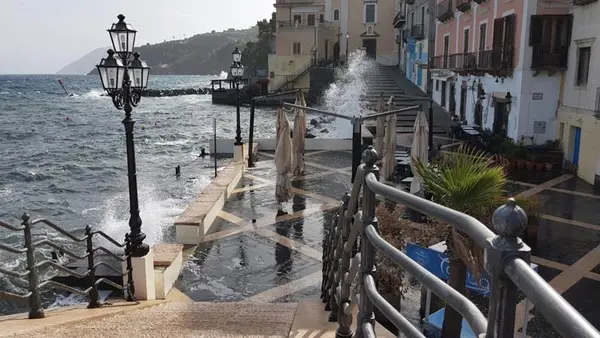 One of the worst storms in Italy in years
One of the worst storms in Italy in years Personally, I didn’t find the weather that bad, but in Italy it was one of the worst storms for several years — it even sank a ferry. The replacement boat finally arrived, the insurance company covered everything. Due to this and the bad weather, the crew spent an unplanned two days on Lipari, but we did manage to finally finish the advanced sailing trip.
I’m glad we saved the mast. Dealing with the insurance and charter companies was simple and problem-free. If there had been any kind of problem, I would have sacrificed it, of course, but that’s not a quick and easy solution either.
As skipper, I want to thank the entire crew for their patience, courage and hands-on help and for supporting yachting.com. Thanks to all that we managed to get through it together. – Jirka Pacák
How did the crew members feel about it?
Personally, I took this incident as a great sailing experience.
When something happens, you have to use your common sense to judge the situation. Without panicking. Find a workaround. Make a decision. Use the skills of every crew member and fix the problem as simply as possible.
Oddly enough, I see it as a really useful learning experience. Nobody was hurt. The boat’s motor worked, it had enough fuel. How many sailors in the world have the good luck to witness such an event? As an experience, it was priceless.
It’s true that it could have ended completely differently. But those are just ‘what-ifs’. That’s the story of the broken mast.
In short, on advanced sailing trips, crews often deal with challenging situations and for many, it’s like ‘yachting college’. Not every participant is thrilled, of course, when they’re put in harm’s way and they’d much rather avoid those situations.
It was a disaster, but we were really lucky that it all ended well and that there were no fatalities. I would have gladly missed out on this encounter to experience a more ‘normal’ yachting scenario instead, though.
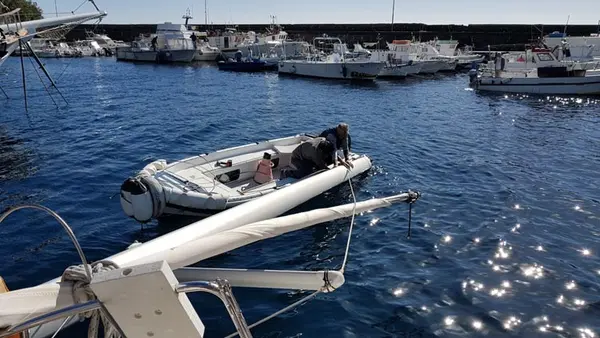 Boat with fallen mast in the marina
Boat with fallen mast in the marina How to prevent an accident on a sailboat and what to do if you find yourself in a similar situation?
- Things can go wrong on any sailing trip and it’s important to never lose sight of that.
- Resolving matters quickly is important, but you always need to remain calm and avoid panicking.
- Whenever an accident occurs, put the boat into neutral and remove any loose parts so nothing gets caught in the propeller. Any worsening of the situation (weather, another accident) may prove fatal if you can’t use the engine. If it’s necessary to use the engine (the boat is heading for a reef), reverse — the stern is ‘cleaner’ and the likelihood of getting lines caught in the propeller is smaller.
- Even if it sounds obvious, it is really important to thoroughly inspect the boat before taking it over.
- Check the tools you’ll need as well (shroud cutters, etc.). Get your own if you sail often.
- Bear in mind that it’s easy to lose radio communication.
- Prepare for deteriorating weather in good time — fold down the bimini top, properly secure the dinghy and place it where it can be accessed quickly. Know where your tools and safety equipment are.
- Use all available resources when dealing with a situation - for example, winches and an anchor windlass are very powerful, which can come in handy.
- In the event of any accident, contact the charter company. Take photos of everything.
YACHTING.COM TIP: Taking over the yacht correctly will save you a lot of time and trouble during your voyage. Take a look at our article on how to take over and hand over your boat to find out exactly what you need to check on your boat before setting sail.
And what else should you do?
- If you frequently sail in challenging conditions, it’s worth getting your own kit – life vests, handheld VHF radio, tools, spare lines and maps you can rely on in critical situations.
- Get deposit insurance. It removes a lot of stress and really helps keep you calm when you’re dealing with a problem.
- Take a first-aid course – you won’t have to call for help, which is usually far away anyway.
- Never forget that responsibility always rests with the captain.
- Whatever you’re aware of that needs to be done on the boat, whether before or during the crossing, do it. Can you think of a problem you can prevent? Prevent it. When something unexpected happens, you’ll be able to fully address the new problem instead of dealing with an old problem.
- Get training, educate yourself, try thinking up various solutions to critical situations.
How to spot a problem before you set sail
A dismasting is a huge complication and can result in serious consequences. There are several warning signs, thanks to which we can prepare for or even prevent the situation. Here is some advice from Jirka Zindulka.
Why does the forestay snap and the mast fall? The main reason is the roller furling genoa. Or rather an improperly installed genoa halyard. When properly installed, the halyard is sufficiently taut and leads from the upper halyard block to the mast exit plates and only then to the masthead sheave.
Quite often there are no mast tangs and the halyard leads straight to the masthead sheave. That leads to unnecessary stress on the upper halyard block. After several years of furling the genoa, it results in it jamming. Especially when under increased pressure during strong winds, the genoa then stops furling smoothly and furls in a jerky, stop-and-start motion.
This looks like the furling line gets tensioned and the genoa doesn’t move. When you pull even harder, something loosens and the genoa rolls up through one or two rotations. When there is only a gentle wind it’s not obvious, but during strong winds furling becomes very difficult or doesn’t work at all. Every time the furling stops, it jams the upper block of the genoa furler. As the block is not rotating, it results in increased pressure on the steel pivots in the upper section.
After several years, individual steel lines start snapping. Then one day, usually while furling the genoa in strong winds, the entire steel line in the upper part of the forestay snaps and out of nowhere the mast crashes onto the deck. Sometimes it happens even without the sails, when choppy seas and forces working on the end of the mast cause the degraded steel line to snap.
In this picture, the correctly installed genoa halyard is on the left (from the halyard lift block to the mast and then to the masthead sheave). In the picture on the right is a commonly used, but incorrect installation. The genoa halyard runs directly to the masthead sheave, which puts too much strain on the halyard lift block.
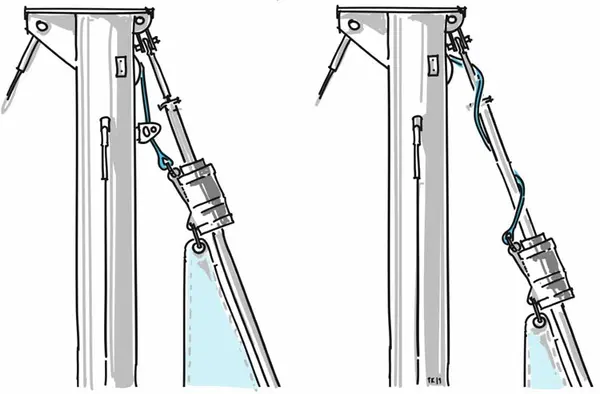 Correctly installed genoa halyard (left) and incorrectly installed (right)
Correctly installed genoa halyard (left) and incorrectly installed (right) When sailing with the engine on, without sails, the mast falls backwards. When under sail, due to the pull on the sails, the mast usually falls to the side. In the case of the cruise to Lipari, the mast fell backwards. The captain couldn’t have avoided the collapse. He still hadn’t taken out the genoa, so he couldn’t have noticed that the furling motion was not continuous.
So can you predict if a mast will fall and prevent it? If you encounter something like this and you find you can’t furl the genoa in strong wind because the roller furling drum won’t turn, then don’t furl the genoa. Also, furl or remove the mainsail. Continue the voyage with an unfurled genoa and when you are sailing leeward and the genoa is no longer buffeted by wind, carefully furl it.
If you have a spinnaker halyard, hook it somewhere around the anchor fittings and properly tense the halyard. If you don’t have a spinnaker halyard or even a spare genoa halyard, you can use a topping lift. If the forestay snaps, even if it is not under any pressure (this is exactly what happened to us when sailing to the Faroe Islands), the taut spare halyard will hold the mast and give you time to sail to the nearest harbour or secure the mast with another line.
Sailing parameters
- Boat: Sun Odyssey 439, year of manufacture: 2012, mast height 18.5 m
- Date: October 27 to November 3, 2018
Sailing route
Do you also want to experience sailing under more challenging conditions? Enjoy similar adventures in the waters around Sicily and the Aeolian Islands. They’re not named after Aeolus, the Greek god of wind, for nothing.
Our range of boats in Italy:
- Sailboat deals°
- Catamaran deals°
- Power Catamaran deals°
Sailboat deals°
Price for a boat per week without compulory fees (end cleaning, bed linens, etc). Hire skipper for 1000-1400 € a week. Contact us for more details.
More offers
